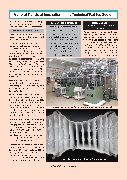General Trends of Innovation in the Technical Textiles Sector ings, durability and waste manage- ment, as well as reduced emissions, water pollution, and carbon footprint.Technological area: Structures Research lines in structuresMain lines of research: Some related lines of research with textile structures are briefly explained in the following lines:More resistant composites, including lightweight and improved manufacturing processes Composites: composite materials re- inforced with structures textiles, made of a polymeric material, metal or ce- ramic (matrix) with a textile structure in fiber, yarn, braid or cloth form. Re- search work focus on obtaining more durable and lighter composites, as well as improving manufacturing process- es. Also, noteworthy is the research into the use of natural fibers for com- posites production; these fabrics (lin- en, sisal, etc.) are used as fiber sub- stitutes of glass in some technical ap- plications.Creation of 3D structures using high technological value yarns, new manufacturing processes for new applicationsResearch lines in structures Seamless productsResearch lines in functionalization treatments: plasma Plasma is an ionized gas made up of electrons, ions, photons, atoms and gas molecules in any state of excita- tion. The plasma state, also called the fourth state of matter, has a zero elec- tric charge. This means that, in plas- ma, there are an identical number of components with positive and negative charge, regardless of the charge den- sity, the presence of neutral compo- 3D structures: creation of new struc- tures using high-tech fibers, new man- ufacturing processes (machinery), new applications (aeronautics, sport, con- struction, etc.) Seamless fabrics: manufacturing tech- nology of seamless knitting allows the direct obtaining of ready-made pieces. Knitted fabrics with minimal seams have been in the market for many years. In this topic the fully-fashion technique must be mentioned, which aim is to get directly required garments the minimum finishes.Image: seamless machines (Source: apparelresources.com) In the field of fabric manufacturing machinery, innovation focus on obtain- ing equipment that offer more produc- tion, lower energy consumption, a prod- uct with a higher quality, the trend to the “Zero defect” and, above all, “smart manufacturing” is pursued. “smart man- ufacturing” aim is the production effi- ciency and its automation. It should be noted that the character- istics of the behavior of the textile structures are conditioned, in addition to the geometry of the structure itself, also by the chemical nature of the fi- bers used and, in many cases, by the operations that are applied to them.Image: 3d spacer fabric (Source: 3dweaving.com) NCM-OCTOBER 2021 48
